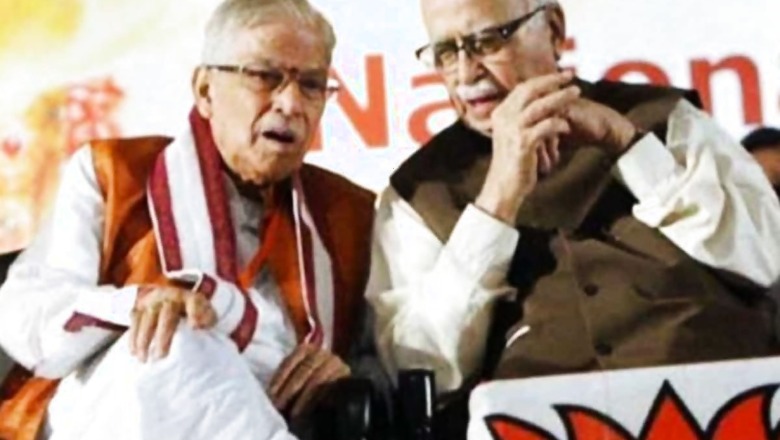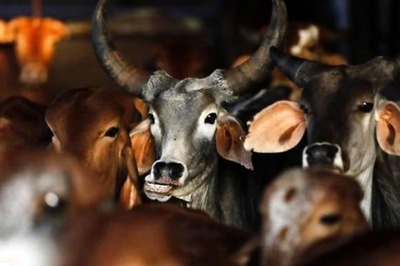
views
No other event or movement has defined contemporary Indian history and politics more than the Ram Janmabhoomi- Babri Masjid dispute. The Supreme Court decision last year brought to an end the protracted case, paving the way for the construction of a temple precisely at the site where the mosque once stood. A case that has a history of legal dispute from 1857, however, truly came to influence Indian society and politics 1980 onwards. At the helm of it were some significant faces from different sides. People for the movement and the countermovement. Those who gained from the turmoil and those who lost.
Amid the galaxy of pro-temple agitators, dominating the spectrum was the troika of an ascetic from Ayodhya, an engineer turned full-time RSS pracharak (proponent) and a politician born in erstwhile Pakistan. They were Mahant Ramchandra Paramhans Das, Ashok Singhal and Lal Krishna Advani. While the first two are no more, 92-year-old Advani is set to see his dream come true in Ayodhya.
Paramhans Das and Ashok Singhal
Born in Bihar in 1913, Ramchandra Paramhans Das shifted to Ayodhya in his early years and became a sadhu. In 1949, when idols were placed inside the mosque, Das was the city president for the Hindu Mahasabha. Though he was never named as an accused in the case, many believed he played a part in the events of the intervening night of December 22-23.
In 1991, in an interview to The New York Times, Das had admitted to his role in placing the idols inside the mosque. When the temple campaign gained pace in the 1980s, Das became the chairman of the Ram Janmabhoomi Nyas and was a key figure among saints and seers closely associated with the RSS and BJP’s movement. He was also an accused in the 1992 Babri Masjid demolition case. Das passed away in 2003.
His close associate was Ashok Singhal. Born in 1923, Singhal obtained his degree in engineering from Banaras Hindu University, but became a full-time RSS pracharak in 1942. After that, he dedicated his life to the Ayodhya movement. In 1981, as the Sangh focused its attention on the Ram Janmabhoomi matter, Singhal was shifted as national joint secretary of the Vishva Hindu Parishad. He gradually became a key face of the RSS, linking the BJP with the saints and seers, spearheading the temple movement. Singhal moved on to become the president of the Hindutva outfit. He was also one of the key accused in the demolition case. He died in 2016.
ADVANI AND THE TEAM — MM JOSHI, KALYAN SINGH, UMA BHARTI AND VINAY KATIYAR
Though the biggest gainer from the Ram temple movement was Atal Bihari Vajpayee, whose moderate Hindutva image led to his emergence as an acceptable face for Prime Minister in the era of coalition politics in the late 1990s and early 2000s , it was Advani who played the most pivotal role in the BJP’s crusade on the Ayodhya issue.
Becoming the president of the party in 1989, he set the ball rolling with his controversial Rath Yatra from Somnath to Ayodhya in 1990. The yatra which saw many communal riots and bloodbath, propelled the BJP in a big way in national politics. Advani, however, got categorised as a hard liner, who had to be content being number two to Atal. An accused in the mosque demolition case, Advani became deputy prime minister in the Vajpayee government.
In 2009, it was the final opportunity for him to be the Prime Minister, but with the BJP losing the electoral battle to the Congress, it was time for emergence of new leadership in the party under Narendra Modi.
But the story of the Advani era is not complete without Murli Manohar Joshi, his compatriot in national politics, and Kalyan Singh, Uma Bharti and Vinay Katiyar. Joshi, a professor of Physics at Allahabad University, was a founder member of the BJP, along with Vajpayee and Advani. He was the BJP's national president in 1992, when Babri Masjid was demolished.
A co-accused with Advani in the demolition case, Joshi for long dominated the political spectrum, only to gradually fizzle out because of growing age and change in the party leadership. He and Advani are now part of the nondescript 'Margdarshak Mandal' of the BJP.
While Advani and Joshi ruffled the Hindutva feathers at the national level, it was Kalyan, Uma Bharti and Katiyar who fired the movement on the ground in Ayodhya and Uttar Pradesh. They brought a new shrillness and aggression to the movement. While it was under the Kalyan Singh government in 1992 that the mosque was demolished, Uma Bharti was the fiery sadhvi who became the symbol of women and religion in the movement. Vinay Katiyar was the face of the militant, dreaded youth outfit Bajrang Dal, associated with the RSS.
While Uma went on to be the chief minister of Madhya Pradesh, Katiyar too entered national politics, becoming a Member of Parliament for several terms. All of them are accused in the demolition case, but as of now have been pushed to the fringes within the party.
THE MUSLIM SIDE: ALI MIYA, ZAFARYAB JILANI, AZAM KHAN AND HASHIM ANSARI
As the temple movement gained pace from the 1980s onward, the socio-political space also saw the emergence of a countermovement, both at the religious as well as political level. The All India Muslim Personal Law Board (AIMPLB) and, under its umbrella, the Babri Masjid Action Committee rose to prominence.
The names of Ali Miya, Hashim Ansari, Zafaryab Jilani and Azam Khan were established as voices of the countermovement. In 1986, as the gates to the mosque in Ayodhya were opened, Ali Miya, the-then president of AIMPLB, called for a crucial meeting of the board, and thereby paved the way for the formation of the Babri Masjid Action Committee.
Advocate Zafaryab Jilani and Azam Khan, the sitting Samajwadi Party MP, were elected as it’s first conveners. The board also took on the responsibility of monitoring of the legal trial in the title suit. While Jilani gradually rose to become the leading face of the legal battle for the Muslim side, Hashim Ansari was the veteran among Muslim litigants who had appealed in court as early as in 1961.
After Hashim’s death, his son Iqbal became a litigant in the case. Azam moved on in politics with Mulayam Singh Yadav, going on to become one of the most prominent Muslim political voices against the Sangh Parivar and the BJP.
THE LOSERS: RAJIV GANDHI AND NARASIMHA RAO
However, the story of the major characters of the Mandir-Masjid saga is not complete without defining the roles of the late Rajiv Gandhi and PV Narasimha Rao: the two Congress prime ministers who erred in their judgement, dangerously dabbled with soft Hindutva, and ultimately dented their party’s prospects.
While Rajiv as Prime Minister decided to open the locks of Babri Masjid, thereby unwittingly giving much needed impetus to the BJP and the Hindutva brigade, the Rao government’s failure to prevent the demolition was the final blow. As the saffron brigade had the last laugh, Muslims were further distanced from the Congress.
GAINERS FROM CONGRESS'S LOSS: LALU PRASAD AND MULAYAM SINGH YADAV
Away from the BJP and Congress, new political forces were emerging in the Hindi heartland to gain a foothold. They were the rising political stars amid the new backward caste resurgence under the Mandal wave in the late 1980s: Samajwadi Party patriarch Mulayam Singh Yadav in Uttar Pradesh and Janata Dal’s Lalu Prasad Yadav in Bihar.
While Lalu, as chief minister of Bihar, halted Advani’s Rath Yatra in 1990 and got him arrested, Mulayam as the chief minister of UP in the very same year declared, “Parinda bhi par nahi maar sakta (It's impenetrable),” in response to the VHP-BJP’S proposed kar seva in Ayodhya.
Subsequent firing by the police on kar sevaks in Ayodhya earned Mulayam long-standing loyalty among the minorities. The Congress’s loss was Lalu-Mulayam’s gain. Both built a strong Muslim-Yadav vote base, or the M-Y factor, an electoral formula that still holds weight in the two Hindi states.
THE PRESENT
With a resolution to the lengthy dispute now reached, movers and shakers, gainers and losers of it have mostly been replaced by new players in the political arena. Some of them are dead and others in political oblivion, But the temple, and more so Hindutva and its antithesis, will continue to define India's political landscape for a long time to come.
(This story is Part 2 of a series on Ayodhya's Ram Temple which is set for a grand 'Bhoomi Poojan' on August 5)



















Comments
0 comment